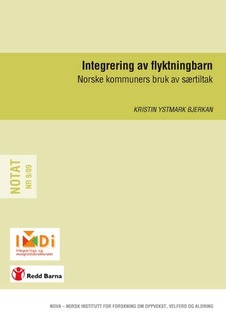| dc.contributor.author | Bjerkan, Kristin Ystmark | |
| dc.date.accessioned | 2020-06-07T21:05:32Z | |
| dc.date.accessioned | 2021-04-29T13:49:23Z | |
| dc.date.available | 2020-06-07T21:05:32Z | |
| dc.date.available | 2021-04-29T13:49:23Z | |
| dc.date.issued | 2009 | |
| dc.identifier.isbn | 978-82-7894-325-0 | |
| dc.identifier.issn | 1890-6435 | |
| dc.identifier.uri | https://hdl.handle.net/20.500.12199/3298 | |
| dc.description.abstract | This publication reports findings from a study of Norwegian municipalities' integration of refugee children after settlement. The main purpose of the study has been to give an account of the municipalities' approach to integration of refugee children and explore to which extent the municipalities implement measures beyond general arrangements. The study asks to what degree do Norwegian municipalities employ special arrangements in integrating refugee children after settlement. The report additionally provides an introduction to Norwegian integration policies directed towards children and the framework which underlies the municipalities' efforts. This involves the influence of economy, competence, politics, and cooperation with central authorities. These issues are explored both through investigation of documents, political premises for the municipalities' responsibilities, and through a survey among Norwegian municipalities about their efforts to integrate refugee children after settlement. Refugee children in Norwegian municipalities Norwegian municipalities are responsible for implementing national integration policy. In regard to children, this involves maintaining the prosperity of refugee children within general welfare arrangements, but the municipalities may also formulate integration efforts in addition to these arrangements. This is a study of Norwegian municipalities' use of special arrangements in the integration of refugee children after settlement. Special arrangements are defined as established arrangements or programs offered to or available to refugee children, but not to other children. The survey shows that 72 % of Norwegian municipalities and urban districts employ special arrangements in the integration of refugee children. Large municipalities report such measures more often than smaller municipalities. Arrangements aimed at increasing social participation and arrange-ments in kindergarten and after-school programs dominate. Respectively 74 % and 83 % of the municipalities which settle refugees employ such measures. Interreligious measures are reported by merely 12 %. Arrangements directed towards the youngest children are most widespread: kinder-garten measures are more common than measures in after-school. Several municipalities state that they do not employ special arrangements in integrating refugee children. For some this could be interpreted as a conscious choice: 34 % do not include special arrangements because they believe general arrangements directed towards children are adequate for promoting the integration of refugee children as well. To others the lack of special arrangements appears to be involuntary: 33 % of the municipalities which settle refugees name lack of resources as the main cause of not implementing such measures. These are prominent causes with most municipalities, but smaller municipalities also report of unsound basis for employ-ing special arrangements due to a low number of refugees in the municipality. 58 % of municipalities which settle refugees report of private actors, special interest organizations or voluntary organizations that provide special arrangements for refugee children after settlement within the municipality. These are to a certain extent concentrated within municipalities that provide such measures themselves. The involvement of non-public organizations seems to correlate with the size of both the refugee population and the total population of the municipality. Non-public organizations mainly provide the same arrangements as the local authorities. Communication and politics This study indicates that municipalities varyingly wish to make and make connection with central authorities in integrating refugee children after settlement. Few municipalities report contact with directorates or ministries, but severalbelieve that such contact influences their integration efforts. This implies a certain unfulfilled demand for involvement. It is difficult to determine how political priorities affect integration efforts within the municipalities. On one hand, no municipalities explicitly express that politics influence their integration strategies. On the other hand, the data show a certain correlation between political constellations and a municipality's approach to the integration of refugee children. This is particularly evident in the emphasis on general arrangements in preference to special arrangements. | en |
| dc.description.abstract | Norske kommuner har ansvaret for å omsette integreringspolitikken til praksis. Dette innebærer i all hovedsak å ivareta flyktningbarns utvikling innenfor det ordinære velferdstilbudet, men kommunene har også mulighet til å utforme integreringstiltak utenfor disse ordningene. Dette har vært en studie av norske kommuners bruk særskilte tiltak i integreringsarbeidet rettet mot flyktningbarn i bosettingsfasen. Notatet viser at 72 prosent av kommuner som siden 2006 har bosatt flyktninger, gjennomfører særtiltak i integreringen av flyktningbarn. Tiltak rettet mot å øke sosial deltakelse og tiltak knyttet til SFO og barnehage er mest utbredt. 1 av 3 kommuner som ikke gjennomfører særskilte tiltak forklarer dette med at generelle tiltak og tilbud til barn og unge er tilstrekkelige for å integrere også flyktningbarn. Like mange kommuner oppgir ressursmangel som hovedårsak. Notatet diskuterer også kommunenes samarbeid med overstående myndigheter i integreringsarbeidet. | no_NB |
| dc.publisher | Oslo Metropolitan University - OsloMet: NOVA | |
| dc.relation.ispartofseries | NOVA Notat 9/09 | |
| dc.subject | NOVA | |
| dc.title | Integrering av flyktningbarn | no_NB |
| dc.type | Notat | |
| fagarkivet.source.pagenumber | 75 | |
